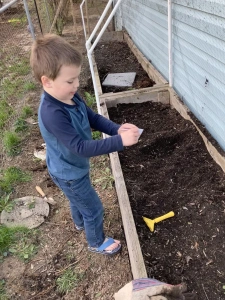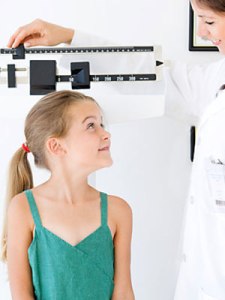When my son was two years old, we planted our first vegetable garden together. We had so much fun planting, caring for, playing in, and exploring our garden that we have planted more vegetables together every year since. Our garden has not been entirely successful in regard to the vegetable harvest, but that’s okay! Research shows that when kids are involved in growing fruits and vegetables, they are more likely to try a greater variety and eat more of them, and the benefits of gardening don’t end there. Even without a successful vegetable harvest, the activity of gardening can help kids engage their curiosity, explore their senses, learn delayed gratification, gain self-confidence, and develop a sense of responsibility. For young children, playing in a garden can help with their physical and mental development. For all children – and adults, too – gardening is a physical and mental activity with benefits for our overall health and wellbeing.
Gardening with children, especially little ones, can be messy. It’s quite common for kids to want to dig and play in the dirt! If possible, designate a “dig zone” where children can play without disturbing the seeds or plants. Reduce your stress and get ahead of any possible mess by:
- Wearing shoes and clothes you don’t mind getting dirty
- Preparing an outdoor handwashing station with soap, a bucket of water and a towel
- Having a towel and change of clothes handy
These tips, and more, came from the children’s book How to Say Hello to a Worm: A first guide to outside by Kari Percival. In the supplemental information included in this book for parents and caregivers, Percival acknowledges that although gardening with young children can be messy, the benefits of gardening outweigh the challenges.
For more information on gardening, including how to grow and harvest vegetables with your family year round, check out the Growing Franklin blog or contact your local Extension office.
Written by Jenny Lobb, Family and Consumer Sciences Educator, Ohio State University Extension Franklin County
Reviewed by Beth Stefura, Family and Consumer Sciences Educator, Ohio State University Extension, Mahoning County
Sources:
Butcher, K. & Pletcher, J. (2017). Gardening with young children helps their development. Michigan State University Extension. https://www.canr.msu.edu/news/gardening_with_young_children_helps_their_development
Moore, M. & Ellis, E. (2022). Kids in the Garden: A Nutritious and Fun Experience. Kids Eat Right. https://www.eatright.org/food/nutrition/eating-as-a-family/kids-in-the-garden-nutritious-and-fun
University of California Master Gardeners of Butte County (2021). Children in the Garden. The Real Dirt Blog. https://ucanr.edu/blogs/blogcore/postdetail.cfm?postnum=46188


